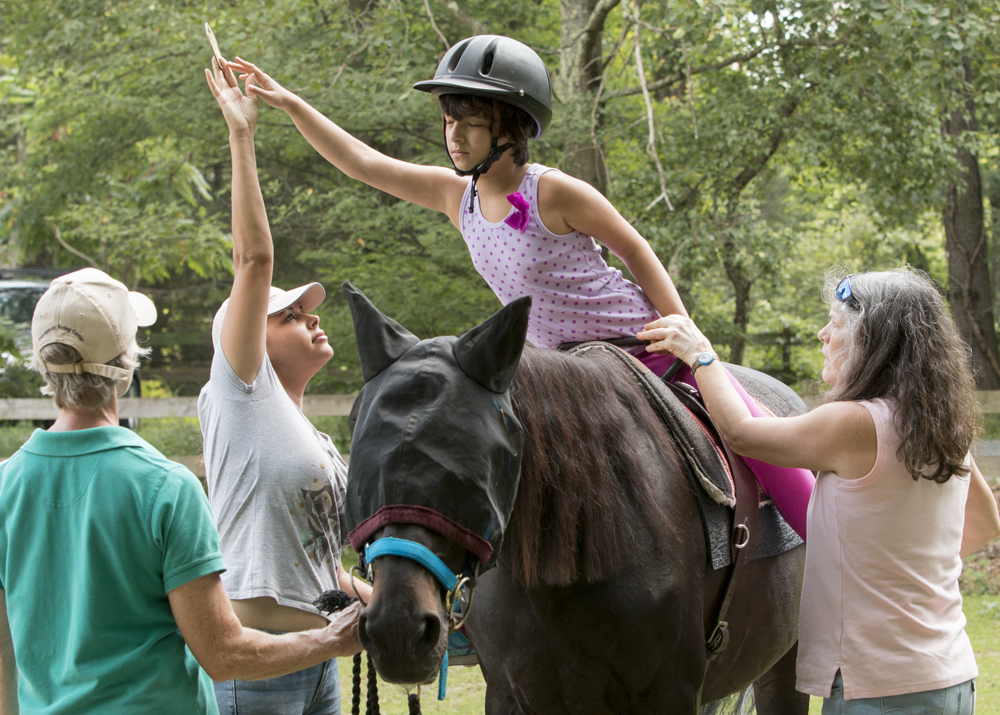Equine Assisted Services
GAIT Equine Assisted Services is a PATH Intl. Premier Accredited Center that offers a variety of equine assisted services (EAS) in horsemanship, learning, and therapy. These programs are designed to meet the needs of children and adults with developmental, physical, and mental/ emotional challenges. We are constantly expanding our programs to accommodate any and all types of disabilities and are always willing to include individuals in EAS activities to the best of our ability. Please contact us for an evaluation and for more detailed information on the wide array of programs offered.
Policies and prices are included on each program application. Mounted activities require medical clearance from a physician and have weight limits to ensure the safety and longevity of GAIT’s horses. These restrictions do not apply to unmounted activities.

Therapeutic Riding (TR)
Therapeutic Riding classes are taught within a group setting by a PATH Intl. Certified Therapeutic Riding Instructor (CTRI) with the assistance of specially trained volunteers.
Lessons are designed to accommodate the physical, mental, and/ or social needs of the rider. The physical act of riding improves balance, posture, trunk control, motor function, and coordination. Increased attention, communication skills, spatial awareness, and socialization are achieved through a series of planned exercises. Participants with a wide array of challenges and varying ages are taught basic horseback riding techniques to control the horse’s movement, such as walking or stopping the horse.
Click HERE to download the Therapeutic Riding application

Equine Assisted Learning (EAL)
PATH Intl. Certified Instructors and Equine Specialists partner with educators to integrate horse- human interaction through planned learning experiences. This experiential learning approach helps individuals to develop life skills for personal, educational, and professional growth.
Sessions are conducted by a certified equine professional who develop activities involving the horse to encourage positive communication, problem solving, and effective coping strategies. They are designed to be safe, educational, and age-appropriate for small groups or individuals to function more happily and self-confidently in their everyday lives. Teens-at-risk — as identified by the school system, youth advocacy programs, or other professional organizations — benefit from this type of program.
Click HERE to download the Equine Assisted Learning application

Equine Facilitated Psychotherapy (EFP)
PATH Intl. Equine Specialists in Mental Health and Learning (ESMHL) partner with licensed mental health professionals and carefully selected horses to address the client’s psychotherapy goals. This experiential approach provides clients with insight for observation and growth while promoting healthy communication, life skills, patience, and confidence.
As prey animals, horses are highly perceptive to subtle changes within their environment. This sensitivity dictates how they will respond to an individual’s changing emotional state. If a client arrives feeling anxious, the horse will respond accordingly. As the client learns to reduce their anxiety, the horse’s behavior will mirror that response. The horse acts as a large biofeedback machine, providing the client and mental health professional with information and skill building opportunities.
Click HERE to download the Equine Facilitated Psychotherapy application

Speech & Language Therapy/ Hippotherapy (HPOT)
GAIT coordinates with a licensed Speech and Language Pathologist and PATH Intl. Registered Therapist to provide Speech Therapy to participants, utilizing the multi- dimensional movement of the horse as a treatment strategy to achieve functional outcomes.
In Hippotherapy, the horse’s natural movement is utilized as a therapy tool/ strategy to provide sensory and motor input. The therapist analyzes the client’s responses and adjusts the treatment (the horse’s movement) with the goal of having the client respond in a very specific way. This unique, three dimensional movement provides sensory input to the brain and nervous system to improve balance, flexibility, muscle strength, motor function planning, postural awareness, and sensory processing.
Click HERE to download the Hippotherapy application